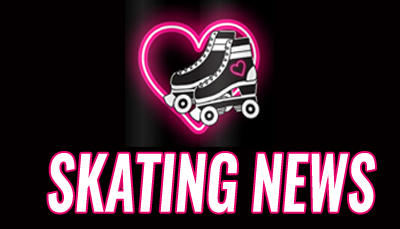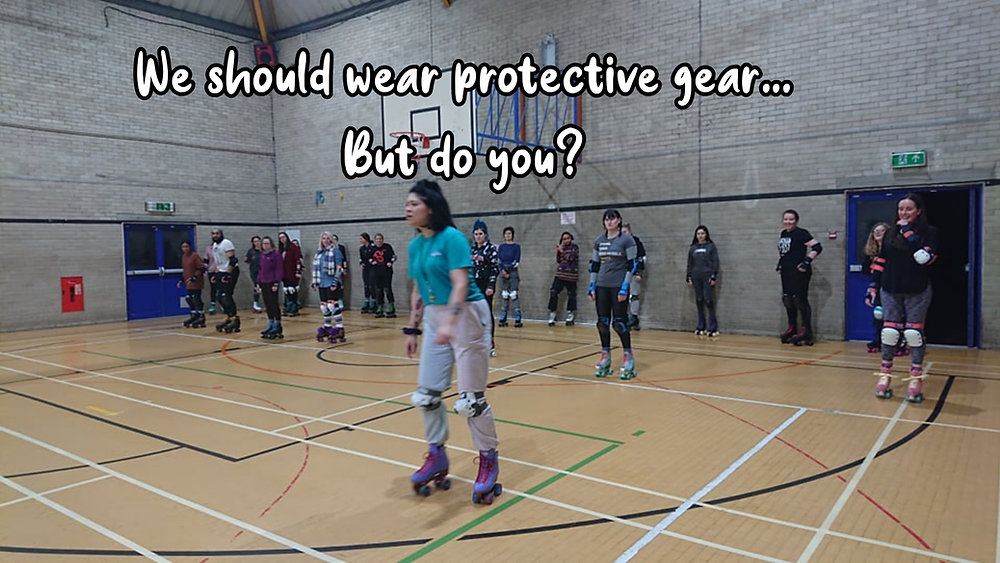by Mel Blackwood
As the title suggests… we know what we should do, but there are many reasons we don’t do things that are the ‘right thing to do.’ The narrative below are my thoughts and suggestions for folks learning to roller skate who have no existing injuries. If you are aware you have an existing injury, then please protect this!

I’ve supported thousands of people early in their roller skate journey and there are firmly two camps. One group of people say “I am very worried about falling so I want as much protective gear as possible – do you have bubble wrap?” The other group look and say “I’ll see how I get on and then put it on if I change my mind.” Of course, the uncontrolled falls that very inexperienced skaters do can cause significant injury, leaving many wishing they had just put the damn things on.
Why don’t we wear protective gear?
-
Putting on protective gear adds time to getting ready to roller skate.
-
We may not know how to put it on, and feel embarrassed that we don’t know.
-
It doesn’t look very cool.
-
If it’s not your own protective gear, it can take even more time to find what you need and it’s overwhelming to try and sort out.
-
It feels like it is constricting your movement.
-
We are more experienced skaters who have decided we don’t need them.
Protective gear cannot prevent injury, but it can significantly lessen any impact. Yes, wearing wrist guards you can still hurt your wrist, but the injury is likely to be less complex than without wearing them.
When should you wear protective gear?
Protective gear is made up of lots of different elements – helmet, wrist guards, elbow and knee pads, bumsavers and even chest protection or shin guards for roller derby or hockey players.
We suggest that when you are learning something new, that your body has not yet learned the balance point for – the time when you are most likely to fall – is the time you should put something on. By the time you have repeated the learning cycle a few times, you will likely know your body and how you fall, so you may choose to wear knee pads only or wrist guards only. You may also decide to purchase a different grade of protective gear – some brands offer higher levels of protection than others. The very nice memory foam found in S1 Gen 4 knee pads makes them far more suitable for serious ramp skating than the thin layer of padding in the REKD sets.
What does learning something new mean?
‘New’ in the context above does not only mean when you are learning to roller skate for the first time. It can also mean
-
when you skate on hills outdoors for the first time
-
when you street skate
-
when you learn a new skate discipline/ specialism eg. artistic / ramp / derby / hockey / roller dance
-
if you are coming to quad skating from a different discipline, eg.
Make the wearing of protective gear easier by owning your own set, even if it is a just-in-case set. Think about how warm your knees get and how surprised you may have been the first time you took your knee pads off…
How much do you want to spend?
Are they a just-in-case set? In which case, just grab a set intended at recreational skaters, like the REKD set. If you care about colour, then expect to pay a little bit more to get a set that will co-ordinate.
What level of comfort do you want? If you are wearing your protective pads for extended periods of time, then you may want to invest in something that has better ergonomic shaping. Try on a helmet if you can – not all helmets are the same shape. We offer this service in Leeds skate shop.
We suggest that protective pads should be snug when you first put them on. They will stretch out in time and you may want to wear clothing under them depending on the time of year.
Also bear in mind that the sets offer excellent value, but you are not able to mix and match the sizes. If the knee pads fit, then you can make everything else work!
Ultimately, we are adults, all capable of making our own decisions about risk. Our decision will be based on our experience and the amount of confidence we have with a given situation.
Check out this YouTube video of a time I was over confident, with the odds stacked against me.
-
The ground was damp.
-
The skates were not my own, so the balance point was slightly different.
-
It was the end of a long day of activity, so my body was tired, even if my mind thought I could cope.
-
It was dark and I couldn’t properly see tiny obstacles.
I did indeed end up falling and hurting both my hand and face. It took a few days for my face to heal and a few weeks for my hand to regain full grip control. What did I learn? That if this presents itself again, I will skate more slowly. I still trust myself and know my abilities and unless I have an injury at the time, it’s likely that I won’t wear pads outside. I have been skating for well over a decade and have a lot of experience skating outside. Having said that there are still things I am not confident to do – including roller skate backwards – as there are still so many tiny obstacles – the risk is too great for me.
Whether you decide to wear protective pads or not is up to you. Take some time to consider what is right for you in each situation so you can skate another day!

